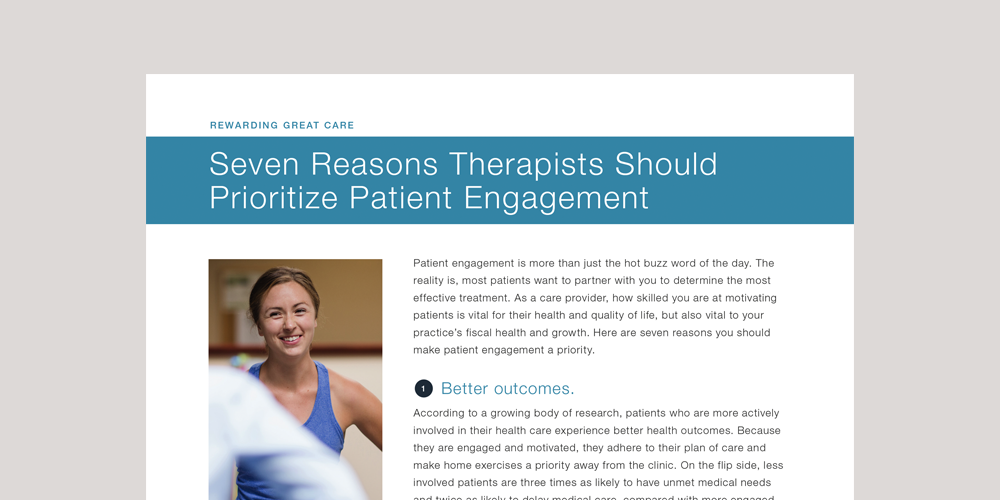Patient engagement has become a popular buzzword in healthcare over the past few years. So much so that according to a HIMSS survey, 72% of respondents stated patient considerations such as “engagement, satisfaction, and quality of care” as some of the most pressing issues facing their organizations over the next two years. Additionally, in a recent survey conducted by Clinicient, nearly 90% of respondents reported patient engagement an essential strategy in improving patient outcomes.
Unfortunately, patient engagement can sometimes get overlooked. Between patient collections and daily documentation tasks, it can be easy to let it slip through the cracks of everyday practice life. But, by encouraging patients to take a more active approach to their care and making patient engagement a priority, you’ll often find that you will improve patient outcomes, lower costs and alleviate some of the pressure that comes from “taking it all on.”
What is patient engagement?
As with most words, definitions become hazy the more it is used. Patient engagement is no exception, with a multitude of existing definitions:
The empowerment of patients to be both willing and able to participate in their own care by cooperating in positive health behaviors.
In today’s healthcare environment, it’s imperative that organizations providing occupational, physical or speech therapy have a robust patient engagement strategy. Here are four reasons why:
1) Engaged patients lower costs
As both payers and providers move to accountable business models, managing patients’ time outside of the clinic has, and will continue to become, a critical priority. Specifically, maximizing at home engagement is the key to achieving better outcomes with fewer in clinic visits, which quite literally is the ideal recipe for success in value-based care. What’s more, there is now published evidence suggesting as much.
2) The modern patient expects it
The explosion of consumer technology across industries has dramatically impacted and influenced the expectations that modern patients bring to a clinic. Just consider the functionality expectations we all have utilizing even our most basic services: personalization, real-time notifications, 24/7 access, interactivity, device accessibility, integration between our most frequently used applications – the list could go on and on.
“The key theme is to know your customer,” Diamond says. “Go to your customer, the patient and engage them. Go with consumer-direct products like every other industry has. In the post-meaningful-use world – providers are digitized like other industries.”
If physical therapy practices stay content with the status quo, their patients will quickly become underwhelmed. This is no different than if a bank failed to provide modern, mobile banking solutions to their customers. Practices resistant to embracing technology may keep their lives easier in the short-term, but not keeping up with technology could be the nail in your [clinic’s] coffin as patients switch to practices offering more modern tools.

Download our free tip sheet today to learn seven reasons why you should prioritize patient engagement in your practice.
Download Now3) Engaged patients achieve better outcomes
The heart of any physical therapy organization is achieving great outcomes. Patients actively engaged in their care achieve superior outcomes as compared to those who are not. Making it easier for patients to be engaged means a greater investment in their care, increased adherence at home and higher patient satisfaction.
4) Engaged patients promote your business
Engaged patients consistently achieve higher rates of patient satisfaction, which means they are motivated to recommend your clinic to a friend or family member–the most powerful source of new referrals. In fact, on average customers tell 9 people about your business after a positive customer experience. Implementing service initiatives like maximizing personalization, remote access to care plans, patient education resources, and corporately celebrating patient success are easy but powerful ways to prevent negative customer experiences, something that providers cannot afford to compromise on in the age of exploding consumerization and patient choice. Why? A whopping 89% of consumers that quit doing business with a company due to a bad customer experience switch to a competitor.
Physical therapy providers possess an incredible value to the healthcare system. However, in order to maximize their value, they must stay ahead of the shifting imperatives in health care. They must pay attention to not only the imperatives imposed by payers and federal regulations, but — just as importantly — those imposed by the pervasive consumerization of the modern patient. When providers begin to embrace reform for value, everyone wins. Patient engagement is a great place to start.

Comments